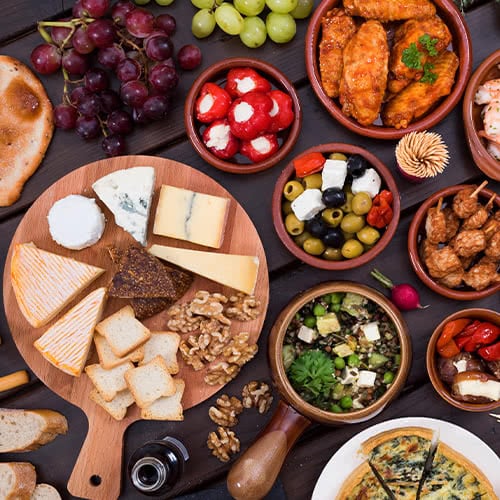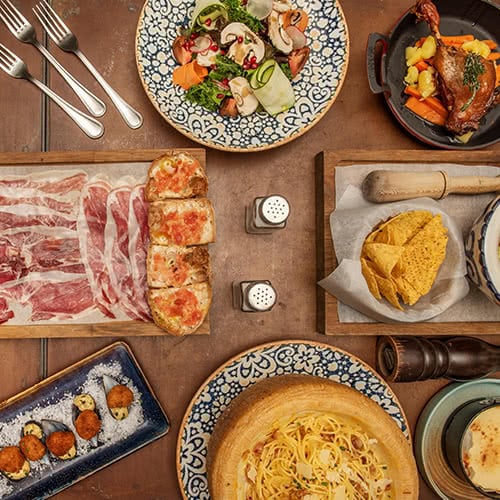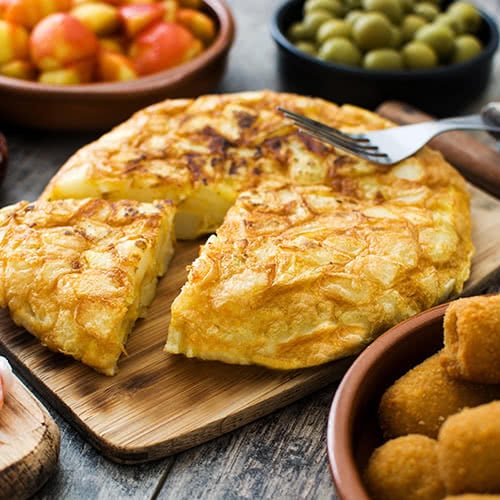Originating in Spain, tapas are small plates of food served as light snacks during happy hour or as appetizers before the main course. Tapas restaurants are growing in popularity in the US because they create a communal dining experience where guests can nibble multiple items without filling up on any dish. They’re essential both to Spanish cuisine and culture. If you visit different regions of Spain, you’ll see how tapas adapt to each community. From its origins to its most popular menu items, sample a selection of scrumptious tapas facts.
What Is Tapas Food?

Tapas is a serving style, not a particular food. Woven into the fabric of life in Spain, the thread began with humble origins. The first tapas were small slices of meat or bread bars provided so patrons could cover their drinks and keep flies away. Over time, these simple and functional bar snacks became as essential as the drinks. They also evolved into extravagant and artfully plated delicacies. They’re traditionally salty, inspiring guests to order more drinks to quench their thirst.
What Does Tapas Mean in Spanish?
Tapas has two meanings in Spanish. As a verb, tapas means “to cover”, revealing its origins as a way for guests to cover their drinks with pieces of food. As a noun, it references small plates of food.
What Does Tapas Mean in English?
In English, we understand the word tapas to mean small portions of Spanish food that are usually served with alcoholic drinks. Popular drink pairings include sangria, tinto de verano, and rebujito.
Types of Tapas

Often served with fortified wine, tapas encompass a wide variety of snacks and small plates. You can categorize tapas into three main categories: cosas de picar, pintxos, and cazuelas. We explain the three types of tapas below.
- Cosas de Picar - The most popular type of tapas, cosas de picar, are finger foods. The term roughly translates to “nibbles.” Examples include marinated olives, marcona almonds, and Manchego cheese slices.
- Pintxos - Pintxos are small finger foods served in bars throughout the Spanish Basque country. The term pintxos means “spike”, which is fitting since these dishes are slices of bread with various toppings skewered with a toothpick.
- Cazuelas - Cazuela tapas are small, sauced dishes served in traditional Spanish terra cotta cazuelas bowls. Cazuela bowls are shallow pots made from unglazed earthenware. Restaurants use cazuelas to both cook and serve food.
Pintxos vs Tapas
Tapas is an umbrella term that encompasses many snacks and small plates, and pintxos are a specific type of tapas. Pintxos are gourmet ingredients stacked atop bread and held together with a toothpick. In contrast, other types of tapas range from finger foods to smaller portions of entrees. Pintxos are popular in the Basque country, and tapas are enjoyed in different forms throughout Spain.
Traditional Spanish Tapas

Tapas encompass a wide range of food items and vary by region. However, there are timeless staples you’ll find at most Spanish restaurants. Upgrade your happy hour menu with these traditional Spanish tapas.
- Tortilla Espanola - Tortilla Espanola resembles a frittata and is often considered the national dish of Spain. Also known as tortilla de patatas, a dense filling of potatoes, onions, and spices is bound together by an egg crust.
- Patatas Bravas - Translating to “spicy potatoes” in English, patatas bravas are one of the most popular tapas in Spain. They’re 2-centimeter-wide white potato cubes that are fried in olive oil until their edges turn a deep brown hue. They offer a satisfying crisp on the outside and a tender, creamy mouthfeel in their center. Tapas bars serve patatas bravas warm with a dipping sauce on the side. Tapas bars in Valencia and Catalonia provide a creamy garlic aioli with their patatas bravas, and Burgos tapas bars offer a spicy tomato-based dipping sauce.
- Jamon Iberico - This cured Spanish ham is perfect for charcuterie boards. It gets its name from the peninsula where the black Iberian pig resides. The pigs that source jamon Iberico are fed an exclusive diet of acorns, olives, and chestnuts. Due to its limited sourcing, specialized diet, and extended curing process, Iberico ham is one of the most expensive foods in the world.
- Croquetas - Croquetas are breaded fritters loaded with a wide assortment of ingredients. There are traditional Spanish croquetas recipes that are vegan friendly, recipes loaded with fresh seafood, or recipes stuffed with Spanish cheese.
- Pan con Tomate - A popular Catalan tapa, pan con tomate is fresh tomatoes, garlic, and premium extra virgin olive oil layered onto rustic bread and served with a dash of salt.
- Gambas al Ajillo - Gambas al ajillo are extra jumbo shrimp sauteed in extra virgin olive oil and covered in garlic, chili pepper, and peppercorn sauce. Some chefs include a splash of sherry or smoked paprika. It’s often served with crusty bread so guests can sop up the remaining sauce.
What Is a Tapas Restaurant?

In Spain, it’s a cultural tradition for groups to jump from bar to bar, ordering a few tapas and drinks at each location. Rather than sitting at one restaurant for an hour or two, this creates a full evening of dining, sipping, and socializing. In the US, tapas restaurants serving traditional Spanish tapas dishes are growing in popularity. While this doesn’t create a bar crawl event, it still allows groups to nibble, sip, and socialize over delicious Spanish small plates and snacks.
When are Tapas Eaten?
In Spain, tapas are eaten either in the afternoon between 1:30 and 3 PM or in the later evening from 8:30 to 10:30 PM. Dinnertimes are notoriously late in Spain and take place between the hours of 9 PM and midnight. An assortment of tapas is the perfect Spanish dinner since they eat their heaviest meal for lunch and enjoy lighter fare for dinner. They can also be enjoyed as a pre-dinner snack or as part of a full course meal.
When in Spain, do as the Spaniards do and nibble and sip your way across town, enjoying delicious regional tapas as you go. Tapas are for sharing and savoring not hoarding and consuming. You can recreate this oft-romanticized experience by offering a tapas menu at your Stateside restaurant. Check out our resource on how to make a wine list to complete your tapas dining experience.



